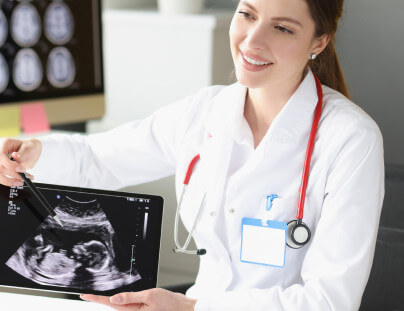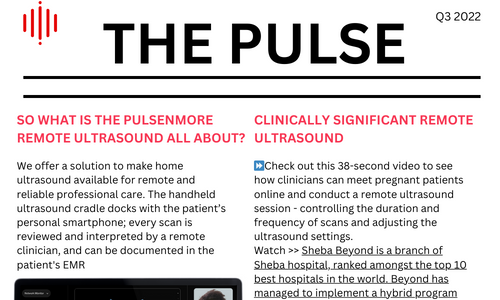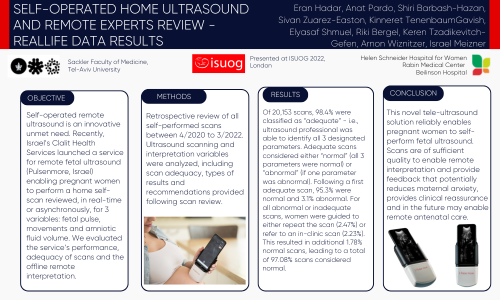The Pulsenmore solution utilizes your smartphone’s processing and video streaming capabilities, communication protocols, display, and power resources. For this reason, not all smartphones meet the compatibility requirements. To insure your smartphone is compatible with the Pulsenmore Home Ultrasound check the Specification webpage.
Home » Events
Resource Center
Explore our comprehensive library of clinical publications, abstracts, news, events, newsletters, marketing materials and press releases.
Discover how Pulsenmore is shaping the future of healthcare delivery
Filter By:

- Newsletters
Get ready to take the lead with next-generation prenatal care. Read on to find out how clinicians can benefit their practice and patients with better access to care, convenience and
- Abstracts, Publications and review articles
Retrospective review of all self performed scans between 4/2020 to 3/2022. Ultrasound scanning and interpretation variables were analyzed, including scan adequacy, types of results and recommendations provided following scan review.
- News
Pulsenmore opens new office in Ramat Gan to accommodate a fast-growing workforce
- Events
Come Meet Us At the 19th World Congress in Fetal Medicine
- Abstracts, Publications and review articles
Remote telemedicine fetal well-being assessment by combining a self-operated fetal heart rate monitoring device and a selfoperated ultrasound device is feasible, time-saving, and results in high patient satisfaction.

the news pulse
We invite you to keep up to date with the latest updates by registering to our quarterly newsletter





FAQ
Frequently asked question
How do I know if my smartphone is supported?
Why is the device single-paitent use?
Our commitment to patient safety and reliable scans guides the device’s design and functionality. The Pulsenmore device, connecting to a patient’s personal smartphone, optimally utilizes smartphone capabilities, minimizing material and resource consumption for enhanced environmental sustainability.
1. The Pulsenmore self-scan device is designed for use within a specific timeframe and usage limit. Extending its lifetime may compromise reading integrity due to material limitations.
2. Responsibility for device maintenance and home storage after the initial period cannot be assumed, impacting transducer quality and ultrasound scan reliability.
3. The device design and validated cleaning protocol do not allow transfer between patients, to avoid cross contamination and infection.
Can the product be used in a pregnancy with multiple fetuses?
No, the product is subject to use in single pregnancies only.
Can the device increase anxiety or create dependency?
The home ultrasound device is designed to provide continuity during pregnancy care and is intended to give you peace of mind.
Can I scan without medical interpretation?
Every scan requires medical interpretation, and it’s important to wait until the files are fully uploaded. You are not expected to understand or interpret the ultrasound scans; just follow the app’s instructions to scan, and receive a response from skilled ultrasound professionals .
Can I view the scans I make through the Pulsenmore App?
You can view the scan in real-time while following the scanning instructions in the app. After the scan, the images are sent to the doctor and cannot be reviewed again.
What is the size of the generated clips?
In the App-Guided mode, the size of the zip file is about 20MB.The Clinician-Guided recorded scan is usually smaller, depending on the amount and length of clips.
How long can scans be viewed on the interface?
Data is available for review for 30 days. During this time, the HCP can download and save the scans onto the patient file. More information is available in our Terms of Use.
Can anyone access the dashboard?
No, the Clinician-Dashboard interface is an online web application that utilizes an active directory access technology (permission management tool).
How does the patient receive her Pulsenmore Scan Key Code?
The Pulsenmore Scan Key Code is generated by the HCP or admin within the clinician dashboard interface.It has unique identifiers based on the patient de-identified ID, selected mode (Clinician-Guided or App-Guided), and prescription details (frequency and time of use).The key is automatically transformed into a QR code and shared with the patient via email or SMS.
Is the device tranferable between patients?
The device is designed for a single patient use, to prevent cross contamination.
Does Pulsenmore use the data for its own purposes?
Pulsenmore utilizes service logs and technical information to improve services and enhance user experience.Pseudonymized clinical data (also referred as de-identified data in the US) is used for clinical education,training, research and development purposes only.









